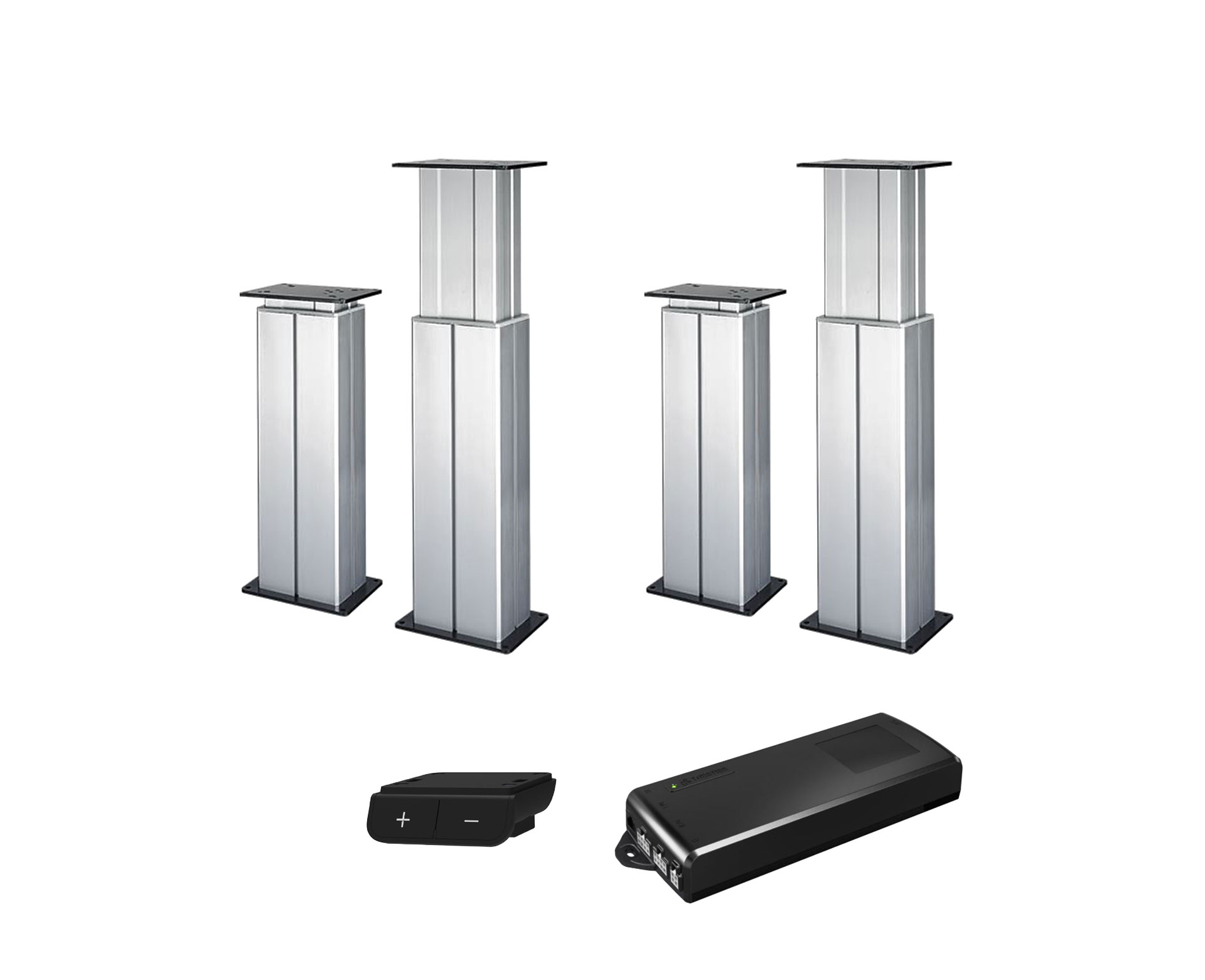
Buy heavy-duty lifting columns
In addition to electric lifting columns for tables and other objects, LinearDirect also has heavy-duty lifting columns in its portfolio, which have a compressive force of up to 8000 N (800 kg) when used in combination. These heavy-duty lifting columns are strong enough to lift or lower heavy loads (always push application only, no tensile load possible).
Update 14.07.2022
Heavy-duty lifting column improvements
Our heavy-duty lifting column is the ideal partner for lifting heavy loads. As we have this heavy-duty lifting column in 3 different versions, we would like to take a closer look at this topic here and share various improvements. Since June 2022, our heavy-duty lifting column has been fitted with improved lubricating micro glide blocks, which further improve the smooth running and lateral guidance forces. In addition to the sliding blocks, the threaded spindle inside the column has also been lubricated with improved grease. The threaded spindle is coated with special, long-lasting and heat-resistant grease of the highest quality. The new grease has very good warm-up properties, which can occur relatively quickly under heavy loads in warm environments. Liquefaction of the grease is prevented.
Synchronisation of the heavy-duty lifting column
The synchronisation of the heavy-duty lifting column is regulated by the control unit using the built-in Hall sensors. This is important, for example, if you want to programme start and end points. Synchronisation is also relevant if you want to use two lifting columns in tandem or multi-parallel operation. Thanks to the Hall signals, the controller always knows the exact height of the lifting columns and can therefore control individual heavy-duty lifting columns so that they do not move too quickly or too slowly. This ensures continuous synchronised movement within the overall system.
Heavy-duty lifting columns Areas of application
Heavy-duty lifting columns are used in various areas. Heavy-duty lifting columns are often required in medical technology, for example to move operating tables or medical beds and chairs up and down electrically. In the packaging industry, heavy-duty lifting columns are used to move pallets. EURO pallets are lifted from a low zone to a certain height in order to be transported on a roller conveyor. Heavy-duty lifting columns are also used to make work easier at the workplace. Here, tables are raised to different heights so that employees are not standing in an ergonomically unfavourable position when carrying out heavy work.
How is a heavy-duty lifting column constructed?
As the name suggests, heavy-duty lifting columns are the ideal partner when it comes to lifting heavy loads. Of course, this requires that the components of the heavy-duty lifting column have the appropriate material thicknesses and qualities. Among other things, the material thickness of the heavy-duty lifting columns, as well as the material quality and diameter of the spindle and its thread pitch are important. The flatter the internal threaded spindle, the more a heavy-duty lifting column can lift. However, the lifting speed slows down as the lifting force increases. This is due to the flattening thread pitch of the spindle.
Where does a heavy-duty lifting column get its power from?
Imagine thefollowing: an M8 threaded rod onto which you screw an M8 nut. Due to the thread pitch of the thread, you can screw (turn) the nut back and forth on the threaded rod relatively quickly. If the thread pitch becomes steeper, the nut is correspondingly faster with fewer turns and if the pitch becomes flatter, you need more turns of the nut to get from A to B on the threaded rod.
The following applies: fast movement=little force / slow movement=a lot of force.
The material of a heavy-duty lifting column
The material of the heavy-duty lifting column is aluminium, usually made from high-quality extruded aluminium. The anodised surface creates a visually appealing product surface. The anodised surface also offers very good sliding properties for the internal sliding blocks. As the name suggests, the sliding blocks are responsible for ensuring that the aluminium tubes do not rub against each other during movement. If there was friction between the individual components, the surface would be scratched and the load to be moved might no longer have a secure hold on the load plane. It would also be possible for the aluminium columns to run in, which would increase the static friction to such an extent that the columns would start to jam. They would literally get stuck. Similar to a piston seizure in a combustion engine.
Mounting a heavy-duty lifting column
Heavy-duty lifting columns, which you can buy in our shop, have a mounting plate made of powder-coated steel at the top and bottom, material thickness between 4-6 mm. These mounting plates (top & base plate) are larger than the outer dimensions of the heavy-duty lifting column. The mounting plates have holes in each corner. You can attach the heavy-duty lifting column to the floor through these holes. You can attach the load level to the mounting plate at the head end.
Maintenance of a heavy-duty lifting column
Dusty use:
Our heavy-duty lifting columns are completely maintenance-free. However, if you use our heavy-duty lifting columns in dusty areas, we recommend daily cleaning of dust on the surface. Dust can, in the short or long term (depending on the size of the dust particles), settle between the sliding blocks and the columns and thus have a massive impact on the sliding properties (over a longer period of time). We therefore recommend cleaning with compressed air or even the use of bellows as dust protection for dusty applications.
Industrial use (mining):
For very dirty applications, for example in the mining industry, we also recommend using a rubber bellows or box bellows to mount the heavy-duty lifting column. The bellows provide very effective protection against industrial residues and dirt and can definitely have a positive effect on or even extend the service life of a heavy-duty lifting column. If you are interested in a box bellows for your heavy-duty lifting column, we look forward to receiving your enquiry.
Industrial clean room applications:
For use in industrial clean rooms or in an operating theatre, the heavy-duty lifting column requires no maintenance whatsoever, as the dust levels are significantly reduced to almost zero by the room air filter systems.
Domestic (private) use:
For applications such as in the living room, we recommend wiping the column elements 1-2 times a year with a cleaning cloth and a little WD40 or silicone spray / Teflon spray. This is completely sufficient. You do not need to do anything else.
Duty cycle (ED) of heavy-duty lifting columns
Every electric motor heats up when doing work. Just as it gets warm when you are actively operating or moving. In fact, the lifting column and the drive become very warm during heavy work. Therefore, every electric drive that does not have its own cooling (ventilation or oil bath, or a combination of both, or a heat sink that radiates the heat into the environment) has a duty cycle (ED). The duty cycle (ED) for most drives is about 2-3 minutes of operation followed by about 15-20 minutes of cool down. This means that you can move the heavy-duty lifting column up and down as often as time and drive speed allow within 2-3 minutes. The drive must then cool down to be ready for use again.
Unfortunately, continuous or permanent use is not possible. In standard use, you cannot operate such a drive permanently either. You can run the drive to the desired positions for 4-7 seconds (or within the specified ED parameters) to reach the desired height. After this, you do your work, which takes a certain amount of time. This allows the motor to cool down again and when you have finished in 10-20 minutes, or however long your work step takes, you can continue to use the drive. You also do not open and close the garage door all the time. Unless you enjoy it. :)
Buy heavy duty lifting columns online
At LinearDirect, we have put together a selected range of heavy-duty lifting columns for you. You can buy heavy duty lifting columns online from us. We have heavy duty lifting columns and heavy duty lifting column sets in our portfolio. Our heavy-duty lifting columns lift loads of up to 800 kg and have a compressive force of up to 8,000 N (Newton)




